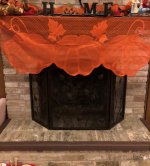Rancher Ed
Gold Member
- Joined
- Apr 22, 2011
- Messages
- 294
- Location
- Texas
- Tractor
- 2008 Kubota M7040 4WD w/loader, 1979? Mitsubishi D2600 4WD w/loader
I grew up with a wood stove and have almost no experience with fireplaces or gas inserts so I am looking for people's experience and recommendations.
BACKGROUND
I have a two story house built in the late 1970s connected to natural gas. The big family room is open to the second floor and has a brick fireplace with an exterior chimney. Either when the house was built or sometime later gas was piped into the fireplace and is pared with some ceramic logs. The thermostat is upstairs and does a great job keeping the bedrooms warm, but on cold winter days the family room is noticeably cooler than upstairs. The current gas setup looks great and does help with the warmth, but you have to manually turn on the gas with a key and light it with long handled lighter, plus most of the heat goes up the open chimney.
I have sealed the ceiling/attic pretty well and blown in 14-18" of fiberglass insulation (a vast improvement from the many holes venting air into the attic and 0-6" of insulation when we bought the house). The house has the original single-pane windows which we will hopefully be replacing in the next year or two. I know the high ceiling plus single pane windows both work against this room being pleasantly warm in the winder. Our summers have highs around 100 and winter lows are typically 30s and 40s with at least a couple weeks in the 20s.
GAS INSERTS
My thought is a gas insert would provide more heat with less gas, be easier for my wife to use, and better seal the chimney all year. I've done a little looking and believe I would want the kind that exhausts out the chimney rather than directly into the room. I know some inserts require electricity for ignition, fans, etc. and can even have a thermostat. I can run power to the fireplace if that is the better choice. During cold stretches in the winter we will likely use the fireplace/insert every day, turning it off at night, but there are also weeks we don't use it at all.
QUESTIONS
1. Which type of gas insert would you recommend and why?
2. Are there specific brands and/or models you would recommend?
3. What features are important vs which ones are marketing gimmicks?
4. Other suggestions I haven't thought about?
Attached is a picture of the fireplace with the existing metal screen in front of it and fall decorations. The opening is about 34" wide x 27" tall. I haven't measured the depth but I would guess it is 18-24" deep, and the sides taper so it isn't as wide at the back.
BACKGROUND
I have a two story house built in the late 1970s connected to natural gas. The big family room is open to the second floor and has a brick fireplace with an exterior chimney. Either when the house was built or sometime later gas was piped into the fireplace and is pared with some ceramic logs. The thermostat is upstairs and does a great job keeping the bedrooms warm, but on cold winter days the family room is noticeably cooler than upstairs. The current gas setup looks great and does help with the warmth, but you have to manually turn on the gas with a key and light it with long handled lighter, plus most of the heat goes up the open chimney.
I have sealed the ceiling/attic pretty well and blown in 14-18" of fiberglass insulation (a vast improvement from the many holes venting air into the attic and 0-6" of insulation when we bought the house). The house has the original single-pane windows which we will hopefully be replacing in the next year or two. I know the high ceiling plus single pane windows both work against this room being pleasantly warm in the winder. Our summers have highs around 100 and winter lows are typically 30s and 40s with at least a couple weeks in the 20s.
GAS INSERTS
My thought is a gas insert would provide more heat with less gas, be easier for my wife to use, and better seal the chimney all year. I've done a little looking and believe I would want the kind that exhausts out the chimney rather than directly into the room. I know some inserts require electricity for ignition, fans, etc. and can even have a thermostat. I can run power to the fireplace if that is the better choice. During cold stretches in the winter we will likely use the fireplace/insert every day, turning it off at night, but there are also weeks we don't use it at all.
QUESTIONS
1. Which type of gas insert would you recommend and why?
2. Are there specific brands and/or models you would recommend?
3. What features are important vs which ones are marketing gimmicks?
4. Other suggestions I haven't thought about?
Attached is a picture of the fireplace with the existing metal screen in front of it and fall decorations. The opening is about 34" wide x 27" tall. I haven't measured the depth but I would guess it is 18-24" deep, and the sides taper so it isn't as wide at the back.

